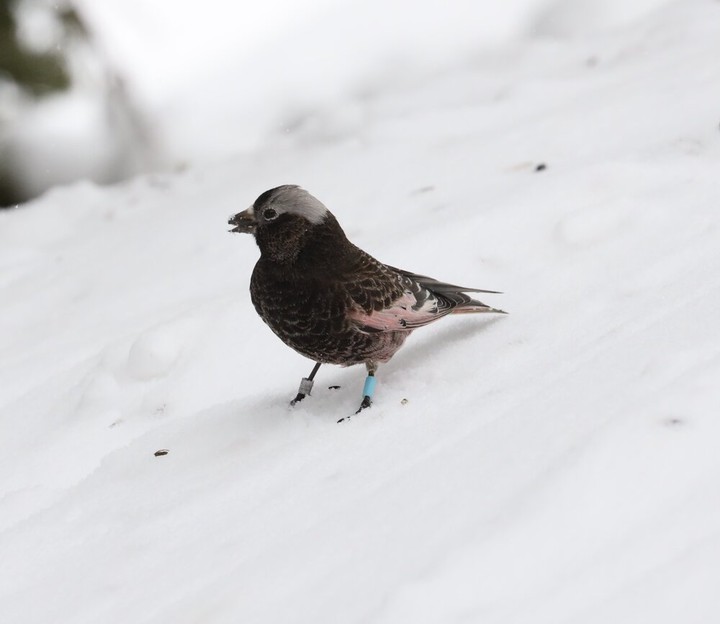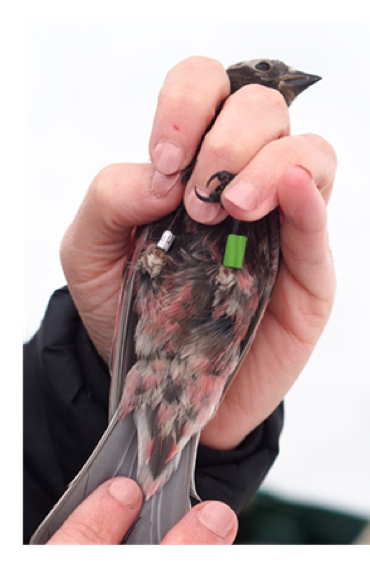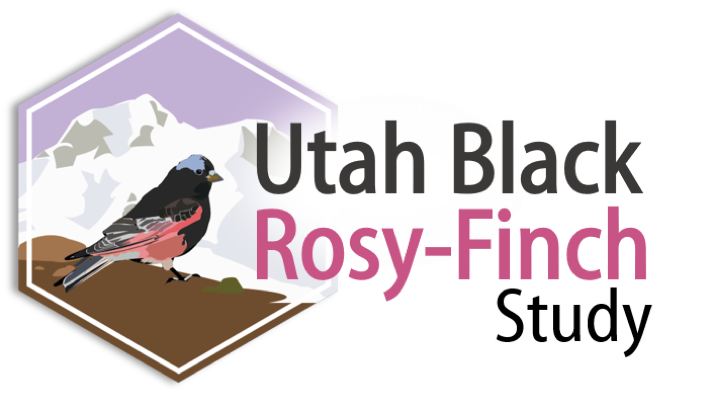Black Rosy-finches
 Photo by Kim Savides
Photo by Kim Savides
Black Rosy-finch (Leucosticte atrata) are one of the least understood birds in North America. Climate change threatens their high-elevation breeding habitat and very little is known about their life history, making them a high priority for conservation. The U.S. Fish and Wildlife Service, Partners in Flight, Utah Division of Wildlife Resources, and U.S. Forest Service identify Black Rosy-finch as a species of conservation concern. A significant hurdle in understanding threats to the Black Rosy-finch and its future well-being is an absence of the most basic life history and demography information. The lack of data limits effective conservation actions critical to ensuring that populations can be sustained, even in the face of threats like climate change. The Utah Black Rosy-finch Study was developed to fill these data gaps, make recommendations based on the data, and conserve the Black Rosy-finch. The project is a voluntary partnership between Utah State University, Tracy Aviary, Wild Utah Project, Utah Division of Wildlife Resources, Department of Defense, and the U.S. Forest Service.
The goal of this project is to understand the life history requirements and demography of Black Rosy-finch in Utah to ensure this species persists into the future, while providing data to managers and practitioners through the specie’s range.
Tracking Rosy-finches using RFID

Since 2019, we have been using RFID-enabled bird feeders to collect encounter data of wintering Black Rosy-finches in northern Utah. The study focuses on bird feeders maintained at ski areas, nature centers, and private residences in northern Utah. Mountain sites provide food for wintering finches, as well as accessible places for data collection. During winter of 2019/2020, we recorded nearly 12,000 visits by 91 tagged Black and Gray-crowned Rosy-finches, including three Black Rosy-finches that were originally banded during the pilot 2019 season. Preliminary analysis of these data suggest that these sites may be used by multiple populations of finches, including over-wintering residents and spring migrants passing through on their way to the breeding grounds. As of November 2020, at least 5 banded birds have been re-sighted at our study sites and we will soon be recording these birds at the RFID feeders.
Over time, these data will allow us to estimate important demographic parameters, including survival, migratory phenology, winter site fidelity, and movement rates. When combined with counts of Rosy-finches across their winter range, these data will also provided critical information about the distribution and abundance of Rosy-finches.
Community science counts

Maintaining a network of RFID feeders in the harsh conditions that Rosy-finches inhabit during the winter prevents widespread adoption of this method across the entire range. To supplement data from the RFID feeders and to be better understand the distribution and habitat requirements of wintering Rosy-finches, we initiated a community science project in 2019 that aims to build a network of volunteers to count Rosy-finches throughout the Intermountain West.
With assitance from the Wild Utah Project and Tracy Aviary, Kim Savides has developed a workshop to train volunteers regarding the objective of the project, how to collect and submit data, identification tips, and strategies for counting flocks of Rosy-finches. Once trained, volunteers conduct 5-7 20-minute counts during pre-defined sampling windows running from January to April. During counts, volunteers record all Rosy-finches seen around their feeder, providing us with critical information about where and when these species occur during the winter.
During the first winter season of this project (2019/2020), volunteers conducted a total of 118 feeder surveys at 17 locations in northern Utah. As of November 2020, over 225 volunteers have signed up to conduct counts during the 2020/2021 season, expanding the scope of our sampling to include Colorado, Wyoming, New Mexico, and Idaho. Stay tuned for more results from this exciting project.
For more information about counting Rosy-finches, visit the project website